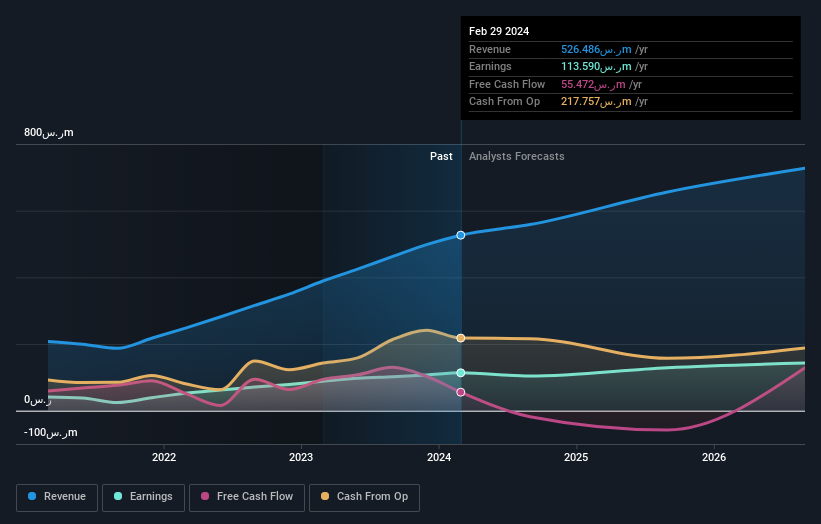- Saudi Arabia
- /
- Consumer Services
- /
- SASE:4291
individual investors who own 54% along with institutions invested in National Company for Learning and Education (TADAWUL:4291) saw increase in their holdings value last week

Key Insights
- Significant control over National Company for Learning and Education by individual investors implies that the general public has more power to influence management and governance-related decisions
- A total of 21 investors have a majority stake in the company with 46% ownership
- Insiders own 23% of National Company for Learning and Education
Every investor in National Company for Learning and Education (TADAWUL:4291) should be aware of the most powerful shareholder groups. We can see that individual investors own the lion's share in the company with 54% ownership. In other words, the group stands to gain the most (or lose the most) from their investment into the company.
While individual investors were the group that reaped the most benefits after last week’s 4.1% price gain, institutions also received a 24% cut.
In the chart below, we zoom in on the different ownership groups of National Company for Learning and Education.
See our latest analysis for National Company for Learning and Education

What Does The Institutional Ownership Tell Us About National Company for Learning and Education?
Institutional investors commonly compare their own returns to the returns of a commonly followed index. So they generally do consider buying larger companies that are included in the relevant benchmark index.
We can see that National Company for Learning and Education does have institutional investors; and they hold a good portion of the company's stock. This suggests some credibility amongst professional investors. But we can't rely on that fact alone since institutions make bad investments sometimes, just like everyone does. When multiple institutions own a stock, there's always a risk that they are in a 'crowded trade'. When such a trade goes wrong, multiple parties may compete to sell stock fast. This risk is higher in a company without a history of growth. You can see National Company for Learning and Education's historic earnings and revenue below, but keep in mind there's always more to the story.

Hedge funds don't have many shares in National Company for Learning and Education. Our data shows that Khaled bin Mohammed Al-Khudair is the largest shareholder with 22% of shares outstanding. Meanwhile, the second and third largest shareholders, hold 22% and 0.4%, of the shares outstanding, respectively.
Our studies suggest that the top 21 shareholders collectively control less than half of the company's shares, meaning that the company's shares are widely disseminated and there is no dominant shareholder.
Researching institutional ownership is a good way to gauge and filter a stock's expected performance. The same can be achieved by studying analyst sentiments. There is some analyst coverage of the stock, but it could still become more well known, with time.
Insider Ownership Of National Company for Learning and Education
While the precise definition of an insider can be subjective, almost everyone considers board members to be insiders. Management ultimately answers to the board. However, it is not uncommon for managers to be executive board members, especially if they are a founder or the CEO.
Most consider insider ownership a positive because it can indicate the board is well aligned with other shareholders. However, on some occasions too much power is concentrated within this group.
Our most recent data indicates that insiders own a reasonable proportion of National Company for Learning and Education. It is very interesting to see that insiders have a meaningful ر.س1.5b stake in this ر.س6.8b business. Most would be pleased to see the board is investing alongside them. You may wish to access this free chart showing recent trading by insiders.
General Public Ownership
The general public -- including retail investors -- own 54% of National Company for Learning and Education. With this amount of ownership, retail investors can collectively play a role in decisions that affect shareholder returns, such as dividend policies and the appointment of directors. They can also exercise the power to vote on acquisitions or mergers that may not improve profitability.
Next Steps:
I find it very interesting to look at who exactly owns a company. But to truly gain insight, we need to consider other information, too. Consider for instance, the ever-present spectre of investment risk. We've identified 1 warning sign with National Company for Learning and Education , and understanding them should be part of your investment process.
If you would prefer discover what analysts are predicting in terms of future growth, do not miss this free report on analyst forecasts.
NB: Figures in this article are calculated using data from the last twelve months, which refer to the 12-month period ending on the last date of the month the financial statement is dated. This may not be consistent with full year annual report figures.
Valuation is complex, but we're here to simplify it.
Discover if National Company for Learning and Education might be undervalued or overvalued with our detailed analysis, featuring fair value estimates, potential risks, dividends, insider trades, and its financial condition.
Access Free AnalysisHave feedback on this article? Concerned about the content? Get in touch with us directly. Alternatively, email editorial-team (at) simplywallst.com.
This article by Simply Wall St is general in nature. We provide commentary based on historical data and analyst forecasts only using an unbiased methodology and our articles are not intended to be financial advice. It does not constitute a recommendation to buy or sell any stock, and does not take account of your objectives, or your financial situation. We aim to bring you long-term focused analysis driven by fundamental data. Note that our analysis may not factor in the latest price-sensitive company announcements or qualitative material. Simply Wall St has no position in any stocks mentioned.
Have feedback on this article? Concerned about the content? Get in touch with us directly. Alternatively, email editorial-team@simplywallst.com
About SASE:4291
National Company for Learning and Education
Owns, establishes, manages, and operates kindergarten, primary, middle, and secondary schools in the Kingdom of Saudi Arabia.
Proven track record with adequate balance sheet.


